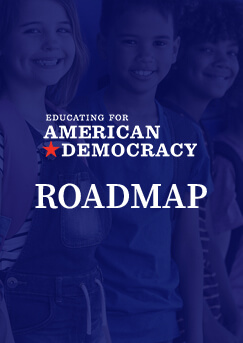The Roadmap to Educating for American Democracy is an inquiry-based content framework for excellence in history and civics for all learners that is organized by major themes and questions, supported by key concepts. It is vertically spiraled across four grade bands (K–2, 3–5, 6–8, and 9–12), and offers a vision for the integration of history and civic education throughout grades K–12.
The document begins by introducing the seven themes around which the Roadmap is organized. It then presents five design challenges that span the seven themes and reflect the six core pedagogical principles presented in its Pedagogy Companion. These design challenges typically involve several valid, worthy, and well-articulated learning goals that exist in mutual tension. They state honestly and transparently some of the rich dilemmas that educators will encounter as they work with the content themes and pedagogic principles.
For each theme, a section defines the thematic questions for K–12 history and civics and the key concepts for grade bands K–5 and 6–12. Following this, the section provides driving questions and sample guiding questions for history and civics, indicated by these abbreviations.



